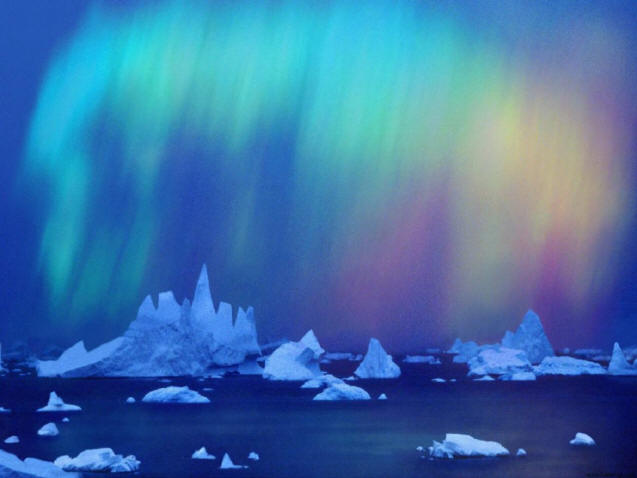|
|
|

Aurora Australis over the Bellingshausen Sea.
Photographer unknown.
Hitched to a Star
Apr 22, 2010
Our fortunes are inextricably
linked to the Sun's activity. This
is a principle tenet of Electric
Universe theory.
Now that is the wisdom of a man, in
every instance of his labor, to
hitch
his wagon to a star, and see his
chore done by the gods themselves.
---
Ralph Waldo Emerson
Many Picture of the Day articles
discuss the linkages between
galactic electric currents, solar
electric currents, and terrestrial
electric currents. Earth is
connected to a circuit that flows
through the cosmos, but that circuit
is difficult to perceive.
Recently, a research team from
UCLA announced the discovery of a
"previously unknown" mechanism for
transmitting energy from the Sun
into Earth's magnetosphere. Charged
particles called the solar wind
erupt from the Sun in all
directions, but how the electric
charge is transferred to the
magnetosphere is a mystery.
Natural processes depend on energy
input of some kind that then changes
from one form to another: chemical
energy is released by fire, which is
then changed into heat energy that
can boil water and drive pistons
with kinetic energy. Consensus views
also suggest that this holds true
for the geomagnetic relationship
between the Sun and Earth.
According to scientists, when the
interplanetary magnetic field (IMF)
slants to the South there is faster
"reconnection" between
interplanetary and terrestrial field
lines, initiating a rapid release of
magnetic fields and plasma from
Earth's sunlit side. How this
happens, as well as how it begins,
are still controversial subjects. In
nature energy cannot be destroyed,
as the conservation of energy law
states, instead it changes state.
For example, when electricity powers
a motor and spins a shaft, the
electromagnetic force is converted
to kinetic energy through angular
momentum. It is thought that
so-called "magnetic energy" can also
reappear in different forms. During
"reconnection" events, conventional
viewpoints say that some of the
magnetic energy becomes heat,
increasing the velocity of plasma
ions and electrons that drive
electric currents in a circuit
linking the plasma sheet with Earth.
Said Larry Lyons, UCLA professor of
atmospheric and oceanic sciences:
"We all have thought for our entire
careers—I learned it as a graduate
student—that this energy transfer
rate is primarily controlled by the
direction of the interplanetary
magnetic field."
Astrophysicists have found that the
IMF can fluctuate in both intensity
and orientation. When the UCLA team
analyzed radar measurements of the
ionosphere, auroral substorms were
seen in that part of Earth's upper
atmosphere ionized by solar
radiation. The results surprised
them.
According to Lyons: "Any space
physicist, including me, would have
said a year ago there could not be
substorms when the interplanetary
magnetic field was staying
northward, but that's wrong.
Generally, it's correct, but when
you have a fluctuating
interplanetary magnetic field, you
can have substorms going off once
per hour."
In the electric Sun hypothesis,
there is no "magnetic reconnection,"
so there is no mystery. The Sun is
an anode, or positively charged
electrode in the vast electric motor
of the galaxy. The cathode is an
invisible "virtual cathode," called
the heliosphere, at the farthest
limit of the Sun's coronal
discharge, billions of kilometers
from its surface. This is the double
layer that isolates the Sun's plasma
cell from the galactic plasma that
surrounds it.
In the Electric Universe model, most
of the voltage difference between
the Sun and the galaxy occurs across
the heliospheric boundary sheath.
Inside the heliopause the weak
electric field centered on the Sun
is enough to power the solar
discharge. As the theory states, an
e-field focused on the Sun
accelerates charged particles: the
faster they accelerate, the stronger
the field. It is that change in
particle acceleration that causes
the IMF variability and the changes
to the electrical input to Earth's
magnetosphere.
Written by Stephen Smith from an
idea submitted by Thane Hubbell
|
|
|
|
|
|
|
|
|
YouTube video, first glimpses of Episode Two in the "Symbols of an Alien Sky"
series.
|
|
|
|
|
|
|
Three ebooks in the Universe Electric series are
now available. Consistently
praised for easily understandable text and exquisite graphics.
|
|
|
|
|
|
|
|
|
|







